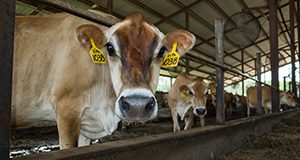The negative effects of heat stress in lactating cows are well known, but only recent studies have explored those effects along with the full benefits of cooling dry cows. Recent work at the University of Florida has demonstrated the benefits of dry cow cooling on calf performance and cow health in the next lactation. This 5-page fact sheet discusses the economic losses from milk production due to heat stress, investment, utilities, maintenance, and feasibility analysis. Written by Fernanda Ferreira, Geoffrey Dahl, and Albert De Vries, and published by the UF/IFAS Department of Animal Sciences, March 2018.
http://edis.ifas.ufl.edu/an342
Tag: Milk Production
Adding Value to Milk by Increasing Its Conjugated Linoleic Acid Content (AN265)

One of the most promising bioactive components of milk is called conjugated linoleic acid. In laboratory animals, this naturally occurring fatty acid has been shown to inhibit cancer, promote the immune system, reduce the effect of type 2 diabetes, promote bone growth, and reduce blood clotting. This 3-page fact sheet briefly reviews dietary strategies for dairy cows that have been used to increase conjugated linoleic acid concentrations in milk and to show how this approach can be used to add value to milk and milk products. Written by Lokenga Badinga and Richard D. Miles and published by the UF Department of Animal Science, July 2011.
http://edis.ifas.ufl.edu/an265
